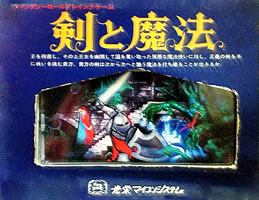
Last week I didn't get to do another entry unfortunately (although I technically didn't announce this as a weekly column anyway), and this one is rather brief as well, as we have another rather impenetrable game at hand. The Japanese title for Koei's next contribution to the genre is literally translated from the term "Sword & Sorcery," and that's what it also says on the title screen of some versions.
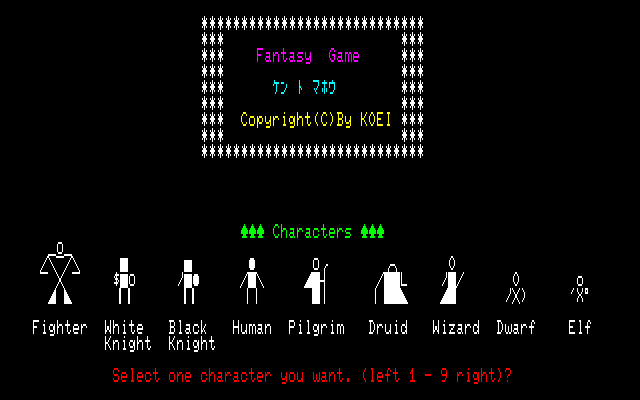
Once again the player controls only a single character, but this time one gets to chose from a range of predefined archetypes. Pictured is the PC-80 version, which builds its graphics entirely with the computer's text character set. The PC-88 and FM-7 versions have more or less defined sprite graphics. Below a screenshot of the PC-88 version from a Japanese site, notice how the Elf got changed into a "Fairly":

After chosing the character, the game shows a list of all the different enemies. In the character-only version, the most impressive are the "Demon C" (row 1 column 3), giant spider (row 2 column 2) and dragon (row 3 column 1). I also like how the torso of the princess that's supposedly to be rescued (lower right) is made up of a heart shape.
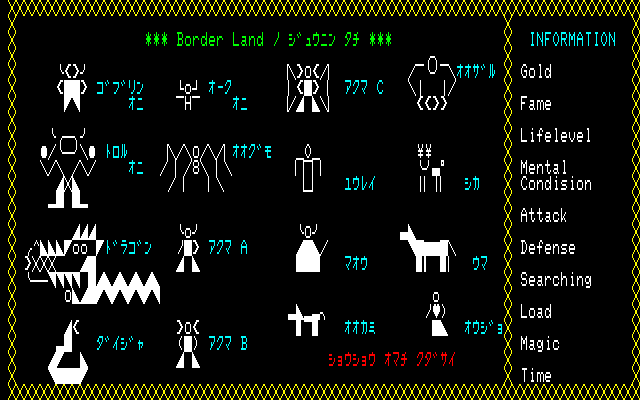
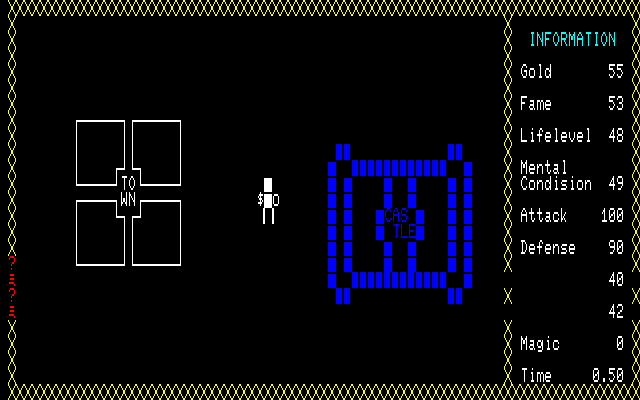
The game always starts out with the hero in between a town and a castle, although their colors and positioning slightly varies each time. It's hard to tell whether the complete world is randomized, or just the starting point within it.
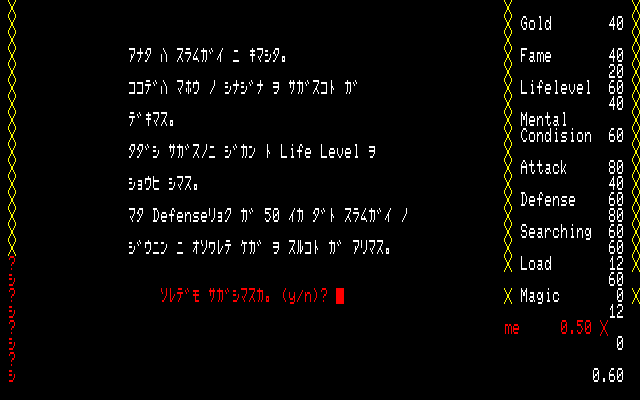
They wouldn't let me into the castle, but the town has the usual RPG mainstays that can be visited by typing numbers from a menu: a church, an inn, a smithy, a marketplace, private homes, a mansion and the slums. The slums are rather interesting: You can let your character search for magic items, but it consumes time and health. In the above screenshot you can also see how the status screen to the right gets all messed up when you make a false input.
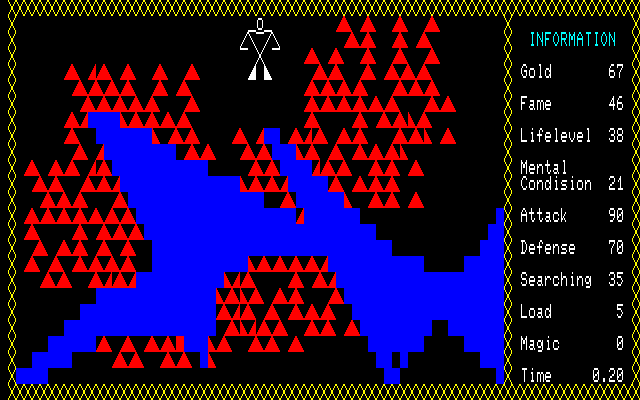
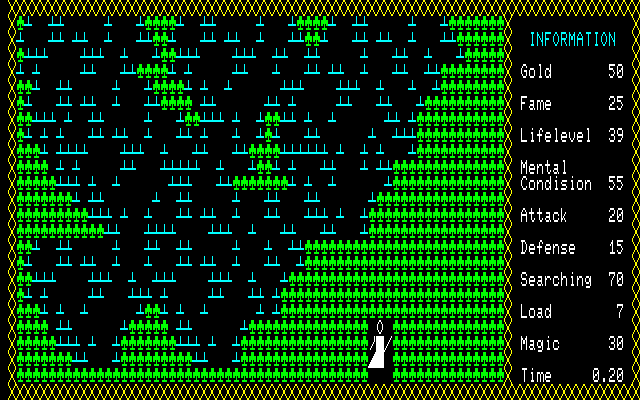
If you wander off from the first screen, you can only guess what kind of terrain the colored characters are supposed to represent. I figured the red triangles were mountains and the blue strucutre a lake, but I could still walk through them. I still never got very far though, because:
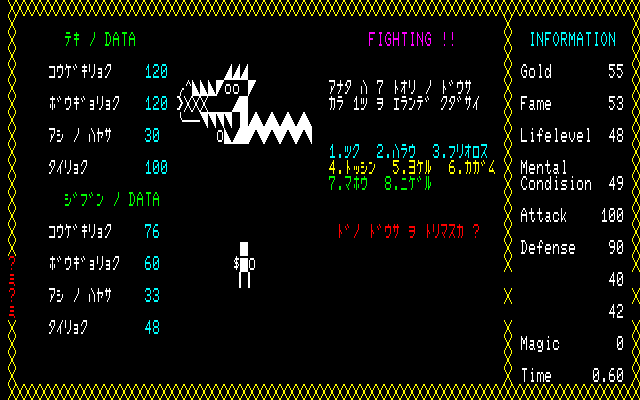
Every few seconds a random encounter is triggered, which brings us to this combat screen. This one is closer to Wizardry than Ultima, but since there's only one hero, the options to chose from have been expanded a bit. The first three are all different kinds of physical attacks, followed by the movements "charge," "avoid" and "stoop." The final two are "magic" and "escape." All this makes the combat sound more deep than it actually is, though: In each round simply both the hero and the monster lose some amount of health, and it goes on like this until one of them drops dead. For some reason the "attack" and "defense" values in Japanese to the left differ from the English ones to the right. I can usually win one or two battles (but not when it's a dragon) before succumbing to the ever attacking random monsters.
Some FM-7 version screenshots from Oh!FM-7:




This game would be my pick as the first "real" RPG made in Japan (although not the first "JRPG", obviously). It has many of usual early fantasy RPG elements that the handful of previous candidates lack, and even features the bog-standard "kill the evil wizard who is wreaking havoc in a generic medieval fantasy world" plot and setting, as well as some of the typical western fantasy monsters (goblins, etc.) that were still somewhat exotic to most Japanese gamers. In an interview with Login magazine from mid '83, Kou Shibusawa even admits that recent releases like Danchizuma and Khufu weren't really true RPGs, but promised that their upcoming games Sword & Sorcery and Dungeon would be "authentic fantasy role-playing games" (interestingly, in the same interview, Shibusawa also laments that he had originally planned for Dragon & Princess to be the first ever Japanese adventure game, but that he was beaten to the punch by Ascii's Omotesandou Adventure while it was still in development). A month or two later, when Login actually reviewed the game, they concluded that it would indeed make a fine introduction to the genre for Japanese gamers. This was around the same time that they were starting to heavily feature the increasingly popular Apple II imports like Wizardry and Ultima, as well as writing quite a bit about western tabletop RPGs such as D&D. So, we can clearly see the stage being set here for the arrival of The Black Onyx and the final popularization of the genre with the more general Japanese computer gaming audience. In the meantime, many of these early efforts would remain somewhat confused as to what an RPG was actually supposed to be like...
ReplyDeleteBy the way, regarding your question about early X1 titles from the Danchizuma post: I'm afraid you're not missing much. The early X1 scene was dominated by simple arcade-style games from the likes of dB-Soft and a few other small companies. Most of these really early RPGs were not ported to the platform, and there were no system exclusives in the genre. The only one of these things that actually originated on the X1 was Enix's very weird Parallel World, but it was quickly ported to the PC-88.
When you Kou Shibusawa, you mean Yoichi Erikawa, right? Where is he now? Has he been interviewed recently?
ReplyDeleteAlso, Brain Breaker, please post more regarding the research you've uncovered in old Japanese magazines. As you can imagine, this stuff is almost impossible to find in the West.
BTW: is your posting name taken from the old X1 computer game, Brain Breaker?
Yeah, I was referring to Erikawa. Shibusawa was the pseudonym he always used back then, so I guess I have a habit of still using it! I can't say I follow the current game industry too closely, but I do think he was featured in an episode of Game Center CX, and a quick google search led to a 2012 interview with Famitsu. There's a funny incident that he was involved in regarding the game Dungeon and the magazine Yuugekishu, which I'll touch on if you guys decide to cover that game here.
DeleteYes, I took Brain Breaker from the game. I saw the feature you guys did on it, which was fantastic! Really great work there. That game hardly received any media coverage in Japan at the time by the way, just the typical small section of a larger Enix ad (which nonsensically called it something like "real rhythm role-playing") and a few very brief write-ups. I'm assuming that it must have been featured in Oh! MZ at some point, but I'm not sure.
Wow, that's awesome. Any chance you can get me readable photos of that 1983 interview?
ReplyDeleteBrain Breaker, any chance you could drop me an email at my HG101 address (UK desk, John), found on our front page?
ReplyDeletehttp://www.hardcoregaming101.net/
There's a project I'm working on (it's unrelated to Deboo's RPG articles), and I'd like your opinion. Where are you based btw - the US, or Japan?
derboo: Okay, I'll give it a shot. Even if they don't come out well, I'm waiting on a new scanner right now, so hopefully I'll be able to do high quality images soon.
ReplyDeleteSketcz: Sure, no problem. I've just sent you an e-mail.